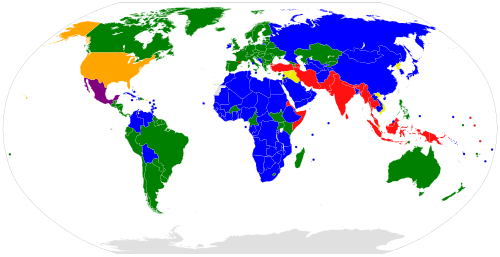Second Geneva Convention

The Second Geneva Convention, officially the Convention for the Amelioration of the Condition of Wounded, Sick and Shipwrecked Members of Armed Forces at Sea (French: Convention pour l'amélioration du sort des blessés, des malades et des naufragés des forces armées sur mer), is one of the four treaties of the Geneva Conventions.[1] The Geneva Convention for the Amelioration of the Condition of Wounded, Sick and Shipwrecked Members of Armed Forces at Sea was first adopted in 1949, replacing the Hague Convention (X) of 1907.[2] It adapts the main protective regime of the First Geneva Convention to combat at sea.[3]
Summary of provisions

Parties to GC I–IV and P I–III | Parties to GC I–IV and P I–II |
Parties to GC I–IV and P I and III | Parties to GC I–IV and P I |
Parties to GC I–IV and P III | Parties to GC I–IV and no P |
The treaty is a lengthy document consisting of 63 articles. The most essential provisions of the treaty are:
- Articles 12 and 18 requires all parties to protect and care for the wounded, sick, and shipwrecked.
- Article 14 clarifies that although a warship cannot capture a hospital ship's medical staff, it can hold the wounded, sick, and shipwrecked as prisoners of war.
- Article 21 allows appeals to be made to neutral vessels to help collect and care for the wounded, sick, and shipwrecked. The neutral vessels cannot be captured.
- Articles 36 and 37 protect religious and medical personnel serving on a combat ship.
- Article 22 states that hospital ships cannot be used for any military purpose, and owing to their humanitarian mission, they cannot be attacked or captured.
For a detailed discussion of each article of the treaty, see the original text[4] and the commentary.[5] There are currently 196 countries party to the 1949 Geneva Conventions, including this second treaty but also including the other three.[6]
See also
References
- ^ "Treaties, States parties, and Commentaries - Geneva Convention (II) on Wounded, Sick and Shipwrecked of Armed Forces at Sea, 1949 - -". ihl-databases.icrc.org. Retrieved 13 April 2022.
- ^ ICRC. "Convention (II) for the Amelioration of the Condition of Wounded, Sick and Shipwrecked Members of Armed Forces at Sea. Geneva, 12 August 1949". Retrieved 5 March 2017.
The undersigned Plenipotentiaries of the Governments represented at the Diplomatic Conference held at Geneva from April 21 to August 12, 1949, for the purpose of revising the Xth Hague Convention of October 18, 1907 for the Adaptation to Maritime Warfare of the Principles of the Geneva Convention of 1906 [...]
- ^ Fleck, Dietrich (2013). The Handbook of International Humanitarian Law. Oxford: Oxford University Press. p. 322. ISBN 978-0-19-872928-0.
- ^ "Convention (II) for the Amelioration of the Condition of Wounded, Sick and Shipwrecked Members of Armed Forces at Sea. Geneva, 12 August 1949". The American National Red Cross. Retrieved 20 November 2009.
- ^ Pictet, Jean (1958). Geneva Conventions of 12 August 1949: Commentary. International Committee of the Red Cross. Retrieved 20 November 2009.
- ^ "States party to the main treaties". The American National Red Cross. Archived from the original on 15 August 2009. Retrieved 5 December 2009.
External links
- Final Act of the Second Peace Conference, The Hague, 18 October 1907